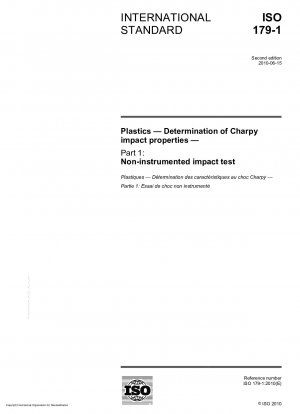ISO 179-1:2010
Plastics - Determination of Charpy impact properties - Part 1: Non-instrumented impact test
- Standard No.
- ISO 179-1:2010
- Release Date
- 2010
- Published By
- International Organization for Standardization (ISO)
- Status
- 2023-06
- Replace By
- ISO 179-1:2023
- Latest
- ISO 179-1:2023
- Scope
- 1.1 This part of ISO 179 specifies a method for determining the Charpy impact strength of plastics under defined conditions. A number of different types of specimen and test configurations are defined. Different test parameters are specified according to the type of material, the type of test specimen and the type of notch. 1.2 The method can be used to investigate the behaviour of specified types of specimen under the impact conditions defined and for estimating the brittleness or toughness of specimens within the limitations inherent in the test conditions. It can also be used for the determination of comparative data from similar types of material. 1.3 The method has a greater range of applicability than that given in ISO 180[1] and is more suitable for the testing of materials showing interlaminar shear fracture or of materials exhibiting surface effects due to environmental factors. 1.4 The method is suitable for use with the following range of materials: ⎯ ⎯ rigid thermoplastic moulding and extrusion materials (including filled and reinforced compounds in addition to unfilled types) and rigid thermoplastics sheets; ⎯ rigid thermosetting moulding materials (including filled and reinforced compounds) and rigid thermosetting sheets (including laminates); ⎯ fibre-reinforced thermosetting and thermoplastic composites incorporating unidirectional or multidirectional reinforcements (such as mats, woven fabrics, woven rovings, chopped strands, combination and hybrid reinforcements, rovings and milled fibres) or incorporating sheets made from pre-impregnated materials (prepregs), including filled and reinforced compounds; ⎯ thermotropic liquid-crystal polymers. 1.5 Notched samples are not normally suitable for use with rigid cellular materials, long-fibre-reinforced composites or thermotropic liquid-crystal polymers. In these cases, unnotched samples may be used. 1.6 The method is suited to the use of specimens moulded to the chosen dimensions, machined from the central portion of a standard multipurpose test specimen (see ISO 3167) or machined from finished or semifinished products such as mouldings, laminates and extruded or cast sheet. 1.7 The method specifies preferred dimensions for the test specimen. Tests which are carried out on specimens of different dimensions or with different notches, or specimens which are prepared under different conditions, might produce results which are not comparable. Other factors, such as the energy capacity of the apparatus, the impact velocity and the conditioning of the specimens can also influence the results. Consequently, when comparative data are required, these factors must be carefully controlled and recorded. 1.8 The method should not be used as a source of data for design calculations. Information on the typical behaviour of a material can be obtained, however, by testing at different temperatures, by varying the notch radius and/or the specimen thickness and by testing specimens prepared under different conditions.
ISO 179-1:2010 Referenced Document
- ISO 10724-1 Plastics - Injection moulding of test specimens of thermosetting powder moulding compounds (PMCs) - Part 1: General principles and moulding of multipurpose test specimens
- ISO 13802 Plastics — Verification of pendulum impact-testing machines — Charpy, Izod and tensile impact-testing*, 2016-04-01 Update
- ISO 2602 Statistical interpretation of test results; estimation of the mean; confidence interval
- ISO 2818 Plastics — Preparation of test specimens by machining*, 2018-12-13 Update
- ISO 291 Plastics - Standard atmospheres for conditioning and testing
- ISO 293 Plastics — Compression moulding of test specimens of thermoplastic materials*, 2023-02-21 Update
- ISO 294-1 Plastics - Injection moulding of test specimens of thermoplastic materials - Part 1: General principles, and moulding of multipurpose and bar test specimens*, 2017-05-01 Update
- ISO 294-3 Plastics — Injection moulding of test specimens of thermoplastic materials — Part 3: Small plates*, 2020-06-26 Update
- ISO 295 Plastics - Compression moulding of test specimens of thermosetting materials
- ISO 3167 Plastics - Multipurpose test specimens*, 2014-08-01 Update
ISO 179-1:2010 history
- 2023 ISO 179-1:2023 Plastics. Determination of Charpy impact properties - Non-instrumented impact test
- 2010 ISO 179-1:2010 Plastics - Determination of Charpy impact properties - Part 1: Non-instrumented impact test
- 2005 ISO 179-1:2000/Amd 1:2005 Plastics - Determination of Charpy impact properties - Part 1: Non-instrumented impact test; Amendment 1
- 2000 ISO 179-1:2000 Plastics - Determination of Charpy impact properties - Part 1: Non-instrumented impact test
